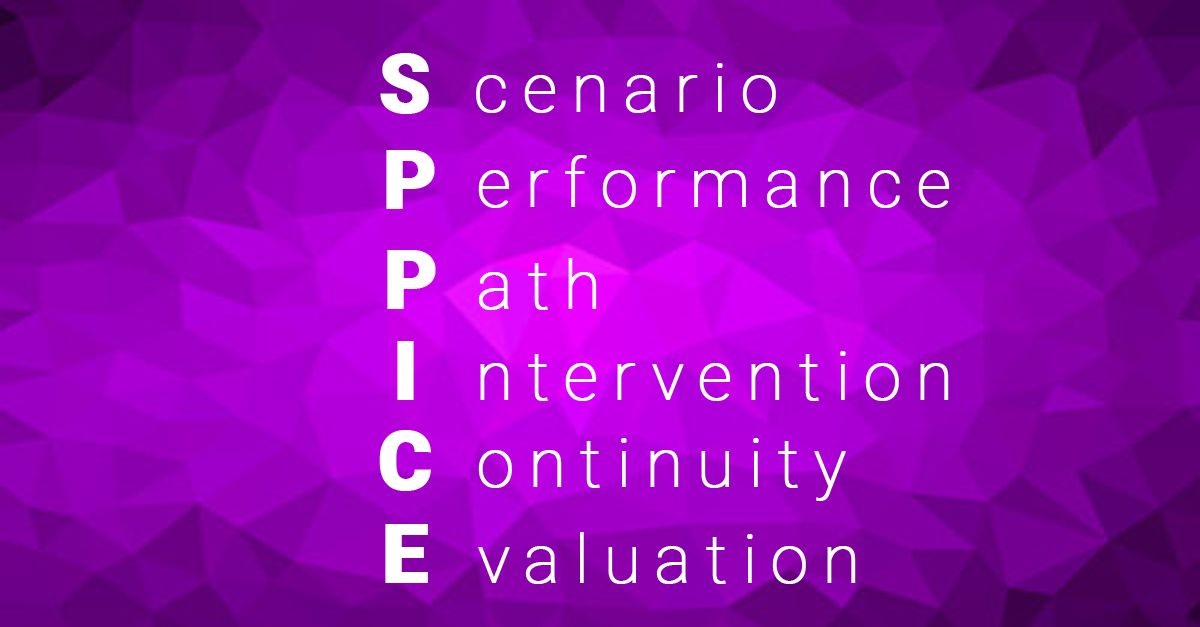The SPPICE model, developed by Infopro Learning, is a learning model for creating simulation-based learning that increases business performance.
Developing the SPPICE Model
The SPPICE model started out like all models at Infopro learning; with a series of problem statements. With learning simulations rising in popularity, justifiably so, many of our customers were asking us the same questions:
- Can a Simulation be used for serious learning?
- What kind of investment is needed to create learning simulations?
- What learning strategy best applies to creating impactful learning simulations? (This was a common one for our customers because they were familiar with models like ADDIE, but they didn’t know if that could be transferred into a more complex learning solution like simulations)
- Are you sure you can simulate the type of situations my employees encounter?
Now, we knew surface level answers to most of these questions, and I’m sure many of you do as well, but we wanted to dig deeper into these questions so we could better understand the science of simulations and why they are impactful.
To help us understand these questions we went back to the drawing board and leaned heavily on research from the brightest and most distinguished minds in the L&D industry. We draw many components from David Kolb, the father of enterprise learning management, David Merrill, an expert on problem centered instruction, and Robert Shank, who founded the learning-by-doing mindset. In our opinion, Robert Shank should be the foundation of any simulation learning model because if you have scene our video on the 70:20:10 model, you will recall the greatest way to learn a new task is by doing it. Last, we studied Roger Mager’s work on defining performance criterion based objectives to ensure we were building simulations that maximized our customers return on investment.
The SPPICE MODEL
After months of research and development, we came up with a learning model for learning simulations that’s targeted at driving business performance. This model is broken up into 6 parts:

Let’s break those down even further:
Scenario
Define the business situation to be simulated and gather information on the audience.
Performance
Outline desired performance outcomes of simulations, such as an increase in Net promoter score.
Path
Create learning paths; a decision tree that maps to performance outcomes identified in the previous stage.
Intervention
Determine how frequently we want to interrupt the simulation with feedback and define what the feedback should be.
Continuity
Measure how the series of decisions made in the PATH will impact the key performance areas and visualize the change throughout the simulation.
Evaluation
Measure performance in the simulation and cross-reference that against the learner’s performance on the job.
The SPPICE Model in Action
After creating the model, we had to test it to see if it worked. We chose to implement SPPICE with three different customers who all had different environments for learning simulations.
- We worked with one company who said their customers are very fickle and tend to switch providers at the drop of a hat. This led to elongated onboarding programs and a hesitancy to let new hires learn on the job.
- Another company in the medical field told us training their employees on new techniques and technology had primarily been hands-on which was very expensive for them.
- The third company had a sales team that primarily worked with customers in a face-to-face setting. This company had no formal training because they believed there was too much variety in the sales process to teach in a classroom.
We worked with each of these companies for several months and analyzed their data at the end of each training program. We were very excited to see the results, and we are happy to tell you they were five stars across the board. We tracked several KPIs to measure the success of the SPPICE model, but we would like to share some of the most impactful performance improvements that were reported:
- The first company that was afraid of letting their team learn from “Trail-by-fire” due to fickle customers, was able to reduce the time to proficiency for new hires by over 50%, saving them hundreds of thousands of dollars in training costs and lost productivity.
- The medical company we worked with whose training was almost 100% hands-on, said the ease of working in the virtual environment led to much more practice than they were able to previously because of the costs to practice. This led to their employees learning new tasks up to 35% faster than before.
- Finally, one of the toughest projects for us was the company whose sales team did not receive formal training due to complex sales environments. Their sales cycle was very long and complex, which required us to spend countless hours in the PATH stage to create the decision tree. So, to see their sales team increase the average order value by 28% was one of our biggest wins.
Although we only highlighted three examples, we have implemented simulation learning for several other organizations that are looking to see drastic increases in performance as well.
Thank you for learning more about Infopro Learning’s Simulations and our SPPICE model. If you would like a personal demonstration of a learning simulation we have built, please call or email us, we would be happy to take you through one.
And for more on creating simulation-based learning, check out our post Simulations: Mimicking the 70%.



